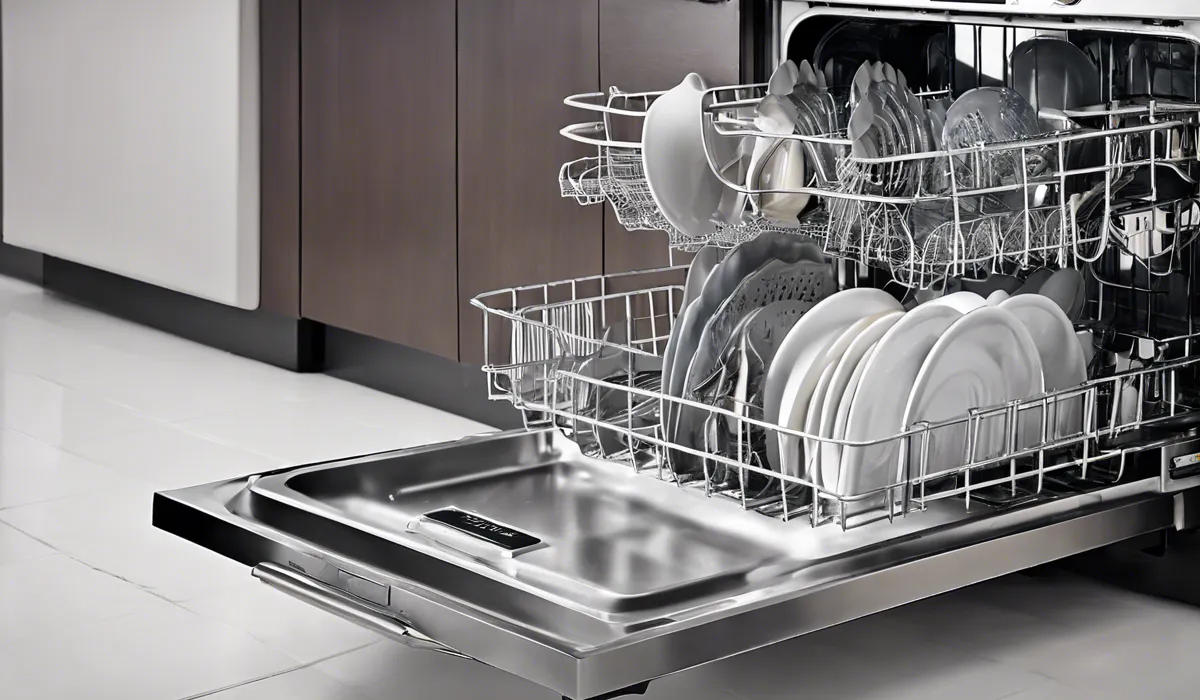Is Dishwasher Steam Toxic? Unveiling the Hidden Dangers
Dishwasher steam is not typically toxic. It mainly consists of water vapor and can include traces of food particles and detergent. However, if the dishwasher is improperly maintained or uses a toxic detergent, there could be a risk. Regular cleaning and safe detergents keep steam non-toxic.
Understanding Dishwasher Steam

Composition of Dishwasher Steam
At the core of the dishwasher’s functionality is steam, a byproduct of the appliance’s ability to clean and sanitize our dishes.
Primarily, this steam is simply water vapor—the same substance that rises from a boiling kettle. However, it may also carry microscopic residues from dishwasher detergent and tiny food particles from the cleaning process.
The heat from the dishwasher helps to dissolve food and grease, which then become airborne with the steam when the machine is opened post-cycle.
Comparison with Steam from Other Household Appliances
Dishwasher steam is not unlike the steam you encounter while cooking on a stovetop or after a hot shower.
However, unlike the steam from a pot of pasta, dishwasher steam may contain traces of detergent chemicals. While these traces are typically very minute, they differentiate dishwasher steam from the more neutral steam produced by boiling water alone.
Factors Affecting the Toxicity of Dishwasher Steam
Several factors can influence the potential toxicity of dishwasher steam. Detergent choice plays a significant role; some contain harsher chemicals than others.
Additionally, the condition of the dishwasher’s filter and the presence of food debris can contribute to the quality of the steam. Regular maintenance and the use of eco-friendly detergents can help minimize any risks.
Health Implications of Dishwasher Steam

Potential Health Effects of Inhaling Dishwasher Steam
Inhaling steam from a dishwasher is generally considered safe. However, exposure to large amounts of steam carrying high concentrations of detergent chemicals could irritate the respiratory system or exacerbate pre-existing conditions such as asthma.
It is important to note that such occurrences are rare and usually due to improper use or maintenance of the appliance.
Risks Associated with Chemicals and Food Particles in the Steam
Chemicals found in some detergents may volatilize in the heat of a dishwasher cycle, potentially causing irritation if inhaled.
Similarly, food particles, although largely harmless, can carry bacteria that should not be inhaled. While the risk is low, it is still something to be mindful of when opening the dishwasher immediately after a cycle.
Safety Measures and Guidelines for Exposure to Dishwasher Steam
Safety measures are straightforward: allow the dishwasher to cool slightly before opening, ensuring the steam has time to dissipate.
Additionally, standing to the side rather than directly in front of the dishwasher when opening the door can minimize exposure. Following the manufacturer’s guidelines for detergent use and maintenance is also crucial.
Mitigating Risks Associated with Dishwasher Steam

Best Practices for Using Dishwashers Safely
To ensure the safe usage of your dishwasher, always follow the instructions provided by the manufacturer.
This includes using the recommended amount of a safe detergent and loading the dishes according to guidelines, which helps in preventing the release of excessive steam. Regular inspections for wear and tear can also prevent unexpected steam leaks.
Ventilation and Air Purification Solutions
Proper kitchen ventilation is essential not just for cooking fumes but also for the steam emitted from dishwashers.
An exhaust fan or an open window can help to disperse steam and any potential residues it may carry. For those particularly concerned about air quality, an air purifier with a HEPA filter can help capture any lingering particles.
Recommendations for Dishwasher Maintenance and Cleaning Products
Regular maintenance of a dishwasher is key to ensuring its steam remains non-toxic. This includes cleaning filters and checking for food build-up.
When it comes to cleaning products, opting for detergents that are phosphate-free and have a clear ingredient list can be beneficial. Some may also prefer natural, plant-based detergents which tend to be milder and less likely to cause irritation.
FAQs About Dishwasher Steam Toxicity
Is dishwasher steam toxic to breathe in?
Dishwasher steam is generally not toxic to breathe in as it primarily consists of water vapor.
Can dishwasher steam contain harmful chemicals?
Dishwasher steam can contain traces of food particles and detergent, but it is not typically harmful unless a toxic detergent is used or the dishwasher is improperly maintained.
How can I ensure that my dishwasher steam is not toxic?
Ensure that your dishwasher steam remains non-toxic by using safe detergents and regularly cleaning your dishwasher.
What should I do if I suspect my dishwasher steam is toxic?
If you suspect toxicity, stop using your dishwasher, ventilate the area, and seek professional maintenance to investigate the issue.
Can the smell of dishwasher steam indicate toxicity?
An unusual smell from dishwasher steam could indicate a problem, but not necessarily toxicity. It’s best to check for maintenance issues or detergent residue.
Final Thoughts
Dishwasher steam is generally not toxic as it primarily contains water vapor. Potential risks can arise if the dishwasher is not well-maintained or if toxic detergents are used.
Ensuring regular cleaning and opting for safe detergents are key practices to maintain the non-toxic nature of the steam emitted from dishwashers.





